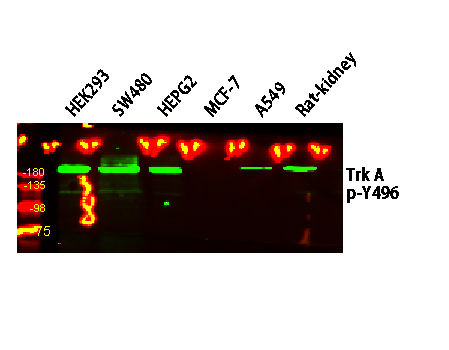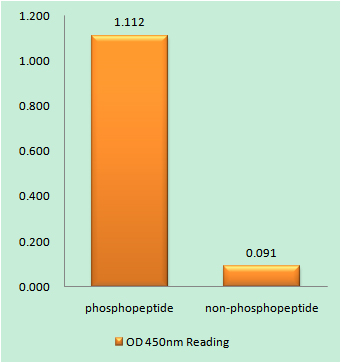Trk A (Phospho Y496) Antibody
- Catalog No.:YP1251
- Applications:WB;IF;ELISA
- Reactivity:Human;Mouse;Rat
- Target:
- Trk A
- Fields:
- >>MAPK signaling pathway;>>Ras signaling pathway;>>Calcium signaling pathway;>>PI3K-Akt signaling pathway;>>Apoptosis;>>Neurotrophin signaling pathway;>>Inflammatory mediator regulation of TRP channels;>>Pathways in cancer;>>Transcriptional misregulation in cancer;>>Thyroid cancer;>>Central carbon metabolism in cancer
- Gene Name:
- NTRK1 MTC TRK TRKA
- Protein Name:
- Trk A (Phospho-Y496)
- Human Gene Id:
- 4914
- Human Swiss Prot No:
- P04629
- Immunogen:
- Synthesized pospho peptide derived from human Trk A (Phospho-Y496)
- Specificity:
- This antibody detects endogenous pospho levels of human Trk A (Phospho-Y496)
- Formulation:
- Liquid in PBS containing 50% glycerol, 0.5% BSA and 0.02% sodium azide.
- Source:
- Polyclonal, Rabbit,IgG
- Dilution:
- WB 1:500-2000; IF ICC 1:100-500; ELISA 1:5000-20000
- Purification:
- The antibody was affinity-purified from mouse ascites by affinity-chromatography using specific immunogen.
- Concentration:
- 1 mg/ml
- Storage Stability:
- -15°C to -25°C/1 year(Do not lower than -25°C)
- Other Name:
- High affinity nerve growth factor receptor (EC 2.7.10.1;Neurotrophic tyrosine kinase receptor type 1;TRK1-transforming tyrosine kinase protein;Tropomyosin-related kinase A;Tyrosine kinase receptor;Tyrosine kinase receptor A;Trk-A;gp140trk;p140-TrkA)
- Observed Band(KD):
- 180kD
- Background:
- This gene encodes a member of the neurotrophic tyrosine kinase receptor (NTKR) family. This kinase is a membrane-bound receptor that, upon neurotrophin binding, phosphorylates itself and members of the MAPK pathway. The presence of this kinase leads to cell differentiation and may play a role in specifying sensory neuron subtypes. Mutations in this gene have been associated with congenital insensitivity to pain, anhidrosis, self-mutilating behavior, mental retardation and cancer. Alternate transcriptional splice variants of this gene have been found, but only three have been characterized to date. [provided by RefSeq, Jul 2008],
- Function:
- alternative products:Both isoforms have similar biological properties,catalytic activity:ATP + a [protein]-L-tyrosine = ADP + a [protein]-L-tyrosine phosphate.,caution:The sequence shown here is derived from an Ensembl automatic analysis pipeline and should be considered as preliminary data.,disease:Chromosomal aberrations involving NTRK1 are a cause of thyroid papillary carcinoma (PACT) [MIM:188550]. Intrachromosomal rearrangement that links the protein kinase domain of NTRK1 to the 5'-end of the TPR gene forms the fusion protein TRK-T1. TRK-T1 is a 55 kDa protein reacting with antibodies against the C-terminus of the NTRK1 protein.,disease:Chromosomal aberrations involving NTRK1 are a cause of thyroid papillary carcinoma (PACT) [MIM:188550]. Translocation t(1;3)(q21;q11) with TFG generates the TRKT3 (TRK-T3) transcript by fusing TFG to the 3'-end of NTRK1; a rearrangement with TPM3 gen
- Subcellular Location:
- Cell membrane ; Single-pass type I membrane protein . Early endosome membrane ; Single-pass type I membrane protein . Late endosome membrane ; Single-pass type I membrane protein . Recycling endosome membrane ; Single-pass type I membrane protein . Rapidly internalized after NGF binding (PubMed:1281417). Internalized to endosomes upon binding of NGF or NTF3 and further transported to the cell body via a retrograde axonal transport. Localized at cell membrane and early endosomes before nerve growth factor (NGF) stimulation. Recruited to late endosomes after NGF stimulation. Colocalized with RAPGEF2 at late endosomes. .
- Expression:
- Isoform TrkA-I is found in most non-neuronal tissues. Isoform TrkA-II is primarily expressed in neuronal cells. TrkA-III is specifically expressed by pluripotent neural stem and neural crest progenitors.
Neural Stem Cells Overexpressing Nerve Growth Factor Improve Functional Recovery in Rats Following Spinal Cord Injury via Modulating Microenvironment and Enhancing Endogenous Neurogenesis. Frontiers in Cellular Neuroscience Front Cell Neurosci. 2021; 15: 773375 IF Rat 1:300 Spinal cord tissue
Neural Stem Cells Overexpressing Nerve Growth Factor Improve Functional Recovery in Rats Following Spinal Cord Injury via Modulating Microenvironment and Enhancing Endogenous Neurogenesis. Frontiers in Cellular Neuroscience Front Cell Neurosci. 2021; 15: 773375 IF Rat 1:300 Spinal cord tissue
- June 19-2018
- WESTERN IMMUNOBLOTTING PROTOCOL
- June 19-2018
- IMMUNOHISTOCHEMISTRY-PARAFFIN PROTOCOL
- June 19-2018
- IMMUNOFLUORESCENCE PROTOCOL
- September 08-2020
- FLOW-CYTOMEYRT-PROTOCOL
- May 20-2022
- Cell-Based ELISA│解您多样本WB检测之困扰
- July 13-2018
- CELL-BASED-ELISA-PROTOCOL-FOR-ACETYL-PROTEIN
- July 13-2018
- CELL-BASED-ELISA-PROTOCOL-FOR-PHOSPHO-PROTEIN
- July 13-2018
- Antibody-FAQs
- Products Images

- Western blot analysis of various lysates, primary antibody was diluted at 1:1000, 4° over night, secondary antibody(cat: RS23920)was diluted at 1:10000, 37° 1hour.


